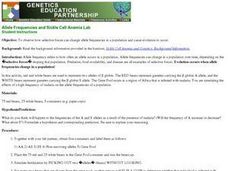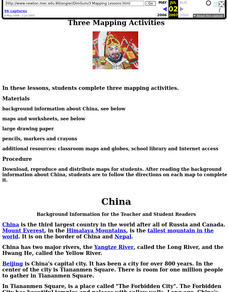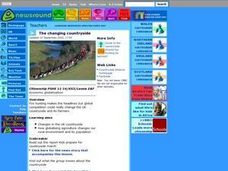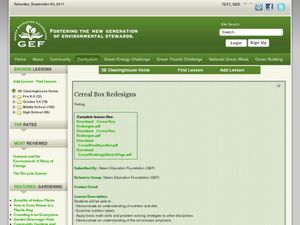Curated OER
All Wrapped Up
Students work in teams to identify and sort types of packaging used in food production. They consider ways to reduce the environmental impact of packaging and reflect how consumer choices play a role in trash production.
Curated OER
Cutting Sandwiches
Students discuss shapes and their characteristics. As a class, they explore shapes made from a square. Students explore triangles, squares, fractions of a square such as a half and a quarter. Individually, they complete worksheets, and...
Curated OER
Heart Healthy
Students assess their risk of heart disease. In this adult health lesson, students differentiate saturated and unsaturated fats. They discuss different heart healthy food ideas.
Curated OER
Money Skills (Using Coins)
Young scholars pretend to purchase items at their class store using coins. At the store, they are to state the amount of the item they want to buy by reading the label. They give the cashier the correct amount of coins and are given a...
Curated OER
Spring Collecting and Identifying Bumble Bees
Students collect bumble bees in the field, record data, pin and label specimens, answer conclusion questions, and send specimens to research leaders for verification. They improve their ability to work in research teams. Students...
Curated OER
Observing Plants
Students identify how plants affect the survival of a caterpillar and what plants need to survive. They plant three bean seeds in the three containers, placing two containers at a sunny window and the third one in a dark closet and label...
Curated OER
Allele Frequencies and Sickle Cell Anemia Lab
Students investigate how selective forces like food, predation and diseases affect evolution. In this genetics lesson, students use red and white beans to simulate the effect of malaria on allele frequencies. They analyze data collected...
Curated OER
Oysters: Impacts on Bay and Economy
Middle schoolers are able to understand the history and economic impact of the oyster, as well as its function in the St. Mary's River Ecosystem. They are provided live specimen for each student to investigate and touch. Students are...
Curated OER
What's the Matter with My Orange?
Students use oranges to informally explore decomposition, dehydration, fermentation, the water cycle, bacteria, yeast, food webs, the needs of living things, and physical vs. chemical change over a period of three or more months.
Curated OER
China: Dim Sum: 3 Mapping Lessons
Fourth graders, after studying maps, draw a very large outline map of Asia and then a large map of China on it in the appropriate place. They label the appropriate information.
Curated OER
A Race Against Time
Students explore the act of preservation first in the process of preserving food and then in the preservation of historic sites, buildings, landmarks, and artifacts.
Curated OER
What Do Plants Need to Grow?
Students in an ESL classroom identify the necessary requirements plants need to grow. Using Spanish worksheets, they label each part of a plant and state their function. They are given cutouts of a picture and the Spanish word in which...
Curated OER
The Changing countryside
Pupils draw a poster showing the costs and benefits of opening up Britain's farmers to the global marketplace. They use a piece of A4 or A3 paper in landscape. Students draw a vertical line to split the page in two. On the left place...
Curated OER
Lead Poisoning and Ceramic Dishes
Students explore the amount of lead in ceramic plates through an experiment. Students determine if everyday dishware is leaching lead into food. They chart their results and discuss how much lead in ceramic dishware may cause lead...
Curated OER
Being Thankful
Young scholars generate words and pictures to show their thankfulness. In this Thanksgiving art lesson, students draw various circles, labeling and illustrating the things for which they are grateful.
University of Georgia
Monohybrid Crosses and The Punnett Square Lesson Plan
Looking for a quick, hands-on activity to teach young scientists about Punnett squares through monohybrid crosses? then check out this one.
Nuffield Foundation
Investigating the Effects of Biochar on Soil Fertility
Breathe some new life into charcoal. Scholars use biochar to improve soil fertility. They test the effectiveness of this addition by conducting an experiment with soil having 0%, 2%, and 4% biochar.
Curated OER
Consumerism - Brand Comparison Lab
The student will have an opportunity for themselves to determine which brand they prefer by comparing national and store brands by their appearance, cost and flavor. They will be looking for the best economical value.
Curated OER
Oh Nuts! - Calories Count
Students measure and record the mass of the nut to be tested to the nearest 0.01 gram.
Curated OER
A Catering Idea
Students plan meals, create a shopping list, determine the cost of the meal, including incidentals such as labor and electricity used. In addition, they consider the cost of plates, table cloths, napkins, etc. Students prepare a meal and...
Curated OER
Nutrition Dictionary Worksheet
In this vocabulary worksheet, 7th graders use words associated with nutrition. Students respond to 10 words, looking each up in the dictionary and writing one fact that they have learned about each specific word.
Curated OER
Medicare Reform
Young scholars calculate how much of each paycheck is deducted into the Medicare system, explain the need for health insurance and Medicare, and work in small groups to develop their own plan to reform Medicare.
Curated OER
Health: Overweight Youth
Investigate the primary causes for the increase in overweight youth and discover its impact on the health care system. After watching segments from the Bill Moyers Now program, your students develop campaigns to implement in school that...
Curated OER
Cereal Box Redesigns
Learners examine cereal boxes for nutrition information. In this nutrition lesson, students redesign cereal boxes to reflect their nutritional value. Learners understand that some cereals contain too high a percentage of sugar...























